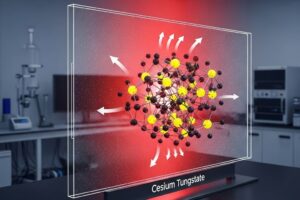As consumer electronics evolve toward lighter, thinner, and higher-performance designs, thermal stability and flame retardancy are becoming more important than ever. BOPET (biaxially-oriented polyethylene terephthalate) is widely used in displays, labels, battery modules, and protective layers for electronic components. This article explores the applications of flame-retardant BOPET films in consumer electronics and highlights the unique advantages of polyphosphonate flame retardants.
Why Do Consumer Electronics Require Flame-Retardant BOPET Films?
Consumer electronics such as smartphones, tablets, laptops, televisions, and wearable devices contain high-density circuit modules and heat-generating components. These devices are susceptible to fire risks caused by short circuits or overheating. BOPET films, used for structural, protective, or insulation purposes, must possess enhanced flame retardant properties to ensure device safety.
Standard BOPET films are flammable and can release toxic smoke and molten drips when burning. Therefore, developing flame-retardant, environmentally compliant, and process-compatible BOPET films is critical.
Performance Requirements for Flame-Retardant Films
In consumer electronics applications, flame-retardant BOPET films typically must meet the following standards:
- Flame Retardancy: UL94 VTM-0 or higher
- Thermal Stability: Resistant to processing and operational temperatures (typically 120–150°C)
- Transparency or Haze Control: Required for display or sensor layers
- Electrical Insulation: Dielectric strength ≥150 kV/mm
- Environmental Compliance: Halogen-free and compliant with RoHS and REACH regulations
Overview of Flame Retardant Types: Pros and Cons
Various flame retardants are used in BOPET and other engineering plastics. Below is a comparison:
- Halogenated Flame Retardants
Pros: High efficiency, low cost, mature technology
Cons: Release toxic gases and corrosive fumes, restricted by environmental regulations - Inorganic Flame Retardants (e.g., aluminum hydroxide, magnesium hydroxide)
Pros: Non-toxic, environmentally friendly, good smoke suppression
Cons: Require high loading levels, which can impair mechanical and optical properties - Organic Phosphorus Flame Retardants (e.g., RDP, BDP)
Pros: Effective for oxygen-containing polymers; some offer good transparency
Cons: Small molecules may migrate or leach, reducing long-term stability - Polymeric Flame Retardants
Pros: Low migration, high compatibility, halogen-free
Cons: Higher cost, requires formulation matching - Nitrogen-Based Flame Retardants
Pros: Environmentally friendly, effective in gas-phase flame suppression
Cons: Lower thermal stability, limited operating temperature range - Nano Synergists (e.g., expandable graphite, montmorillonite)
Pros: Strong synergistic effect, can reduce the amount of primary flame retardants needed
Cons: Ineffective when used alone, challenging dispersion
Polyphosphonate Flame Retardants: A New Choice for BOPET Films
Polyphosphonate flame retardants are emerging as an ideal solution to meet stringent safety and performance standards. As halogen-free polymeric phosphorus-based materials, they offer several key advantages:
1. Excellent Flame Retardancy: UL94 VTM-0 Certified
Polyphosphonates contain stable P–O–C structures that decompose at high temperatures to produce phosphorus-based intermediates. These promote char formation and suppress combustion reactions. BOPET films incorporating the right dosage can achieve UL94 VTM-0 ratings, meeting rigorous fire safety standards.
2. High Thermal Stability: Compatible with Processing Conditions
With decomposition temperatures above 300°C, polyphosphonates are well-suited for BOPET film extrusion and stretching processes. They do not degrade, volatilize, or exude during high-temperature manufacturing, ensuring consistent product quality.
3. Minimal Impact on Transparency: Ideal for Display Applications
Unlike traditional flame retardants (e.g., aluminum hydroxide or antimony trioxide), which reduce film clarity due to particle size, polyphosphonates disperse at the molecular level and exhibit excellent compatibility. This allows effective flame retardancy without significantly affecting transparency, making them ideal for touchscreens and display protection layers.
4. Environmentally Friendly and Halogen-Free
Polyphosphonates do not emit halogenated toxic gases upon combustion and comply with major environmental regulations such as RoHS, REACH, and California Proposition 65, making them suitable for global electronics markets.
Future Trends and Typical Applications
Flame-retardant BOPET films are increasingly used in the following areas of consumer electronics:
- Battery Insulation Pads: Improve fire resistance in lithium-ion battery packs under short circuit or high-temperature conditions
- FPC (Flexible Printed Circuit) Protection Layers: Provide both electrical insulation and flame resistance
- Display Buffer Layers: Used in OLED and LCD modules, offering both transparency and fire protection
- Electronic Labels and Nameplates: Enhance material safety and prevent combustion under high temperatures
- Cable Wraps and Packaging Films: Provide heat and flame protection for charging and data cables
The growing adoption of 5G, AIoT, and wearable technologies continues to drive demand for lightweight, high-performance, environmentally friendly flame-retardant films. Polyphosphonate flame retardants are playing a pivotal role in enhancing BOPET film performance and are increasingly attracting attention in materials research.
Conclusion: Flame-Retardant Films – A Key Step in Electronics Safety
As performance requirements in consumer electronics grow more demanding, flame-retardant BOPET films are becoming essential for product safety. Polyphosphonate flame retardants, with their high efficiency, thermal stability, and environmental compliance, are facilitating the transition to safer next-generation materials. For R&D professionals focused on advanced electronic materials, embracing these novel flame-retardant solutions is critical for innovation and differentiation.







